Economic activity of the population - 3. quarter of 2006
Product Code: e-3133-06
Economic activity of the population in Q3 2006
Employment in the primary sector (agriculture, forestry, fishing) decreased by 2.2 thousand to 188.6 thousand persons year-on-year and made up only 3.9% of the total number of first (main) job holders. The number of persons employed in the secondary sector (industry, construction) increased compared to Q3 2005 by 39.6 thousand to 1 935.0 thousand (40.0% of total employment). This growth was mainly affected by the year-on-year increase of 58.0 thousand in employment that occurred in ‘manufacturing’. The number of employed persons went up most in ‘manufacture of parts and accessories for motor vehicles and their engines’ (+27.1 thousand), ‘treatment and coating of metals; general mechanical engineering’ (+16.0 thousand), ’manufacture of basic iron and steel and ferro-alloys’ and ‘manufacture of other wearing apparel and accessories’ (in both cases +6.3 thousand). Decrease in the number of employed in ‘construction’ by 27.6 thousand proved itself most in ‘building of complete constructions or parts thereof’ and ‘building completion’.1)
Employment in the tertiary sector (all divisions of services including transport) increased by 5.6 thousand to 2 715.0 thousand (56.1% of total employment), but it developed in the individual divisions in an opposing way. Employment increased most in ‘real estate; renting and business activities’ (+28.2 thousand) ‘hotels and restaurants’ (+7.1 thousand), and ‘other community, social and personal service activities’ (+4.6 thousand). Within the section ‘real estate; renting and business activities’ the growth showed mostly in ‘investigation and security activities’, within the section ‘legal, accounting and book-keeping activities; market research and public opinion polling’ in ‘advertising’ and ‘other computer related activities’. In hotels and restaurants employment grew most in ‘restaurants’ and within the section ‘other community, social and personal service activities’ ‘the number of employees increased mainly in the section ‘sewage and refuse disposal, sanitation and similar activities’.
On the other hand, employment dropped most year-on-year in ‘education’ (-11.0 thousand), mainly in ‘primary education’. Employment dropped also in ‘wholesale and retail trade; repair of motor vehicles and personal and household goods’ (-8.1 thousand), most in ‘retail sale of food, beverages and tobacco in specialised stores’.
1) Note: When evaluating the branch structure of the employed it is necessary to take in to consideration the methodology of sample survey, which is carried out only in flats and not in collective accommodation establishments. Data on the number of employed from LFSS is then corrected by statistics within the harmonization with data on employment development of foreign state citizens in the branch. According to the available data from the Ministry of Labour and Social Affairs of the CR this year there has been a marked increase of the number of foreign citizens in construction who mostly do not live in flats.
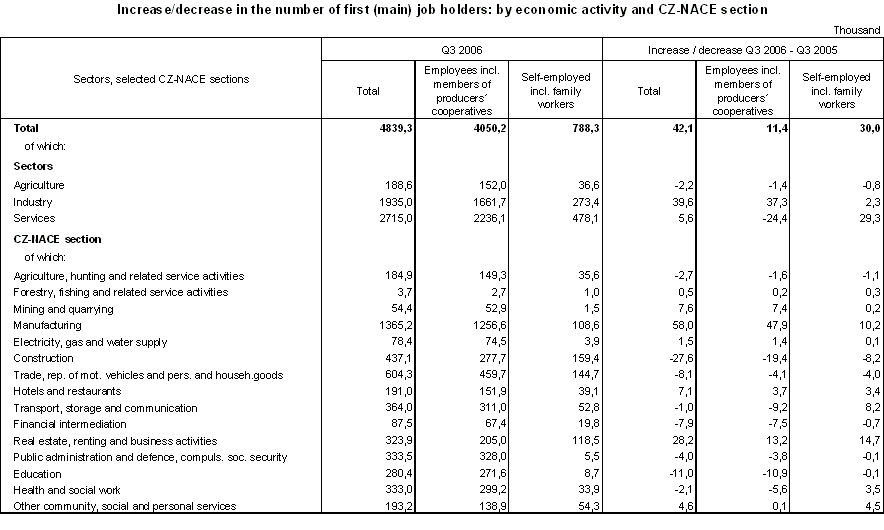
An increase in the total number of self-employed by 30.0 thousand showed itself mainly in the section ‘real estate; renting and business activities’. Year-on-year increase in the number of self-employed persons, including contributing family workers was the highest in ‘advertising’ (+3.8 thousand), in ‘architectural and engineering activities and related technical consultancy’ and within the section ‘‘legal, accounting and book-keeping activities; market research and public opinion polling’ and in ‘ miscellaneous business activities n.e.c.’. In ‘manufacturing’ the number of self-employed increased in ‘manufacture of furniture’ and in ‘transport, storage and communication’ in the section ‘land transport’.
The total employment rate of persons aged 15-64 grew year-on-year by 0.2 percentage points to 65.4%. The relative increase was higher in the employment of women at working age (+0.3 percentage points to 56.8%), while employment of men was 0.1 percentage points up and reached 73.9%. The employment rate is pushed down by a fast growth of the number of students at universities on the one hand, and, on the other hand, the number of persons in employment is increasing due to the concurrence of employment of strong age groups born at the turn of the forties and fifties and in the middle of seventies
Compared internationally, the Czech Republic is among the countries with the above-the-average employment intensity in the EU. According to the latest complete data for Q2 2005 released by the Eurostat, the employment rate of persons aged 15-64 in the Czech Republic was higher than the total for EU25 and not far from the level in the EU15 (however, we should take account of the fast growth of this indicator in the CR during the whole of the last year). Nevertheless, differences in employment rates are considerable, not only if we compare the whole age group 15-64, but also in the male and female components of employment. On the one hand, there is a high level of employment in the northern countries and the United Kingdom (e.g. in Denmark it was only 76.5% in Q1 2006), on the other hand in many countries the level of employment was lower than 60% (in Poland it reached only 53.4% in Q1 2006). Compared to our neighbour states, higher level of employment is in Austria and slightly higher also in Germany, level of employment in Poland and also in Slovakia is, however, significantly lower. Very low unemployment rate is also in Hungary. In the following table, there are apart from data for Q2 2005 also data for Q1 2006 (a qualified estimate was made for some of the countries).
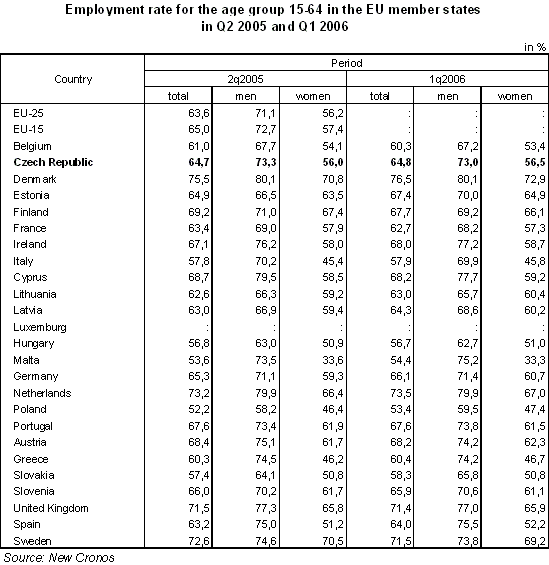
For the CR’s economy a high share of employment in the secondary sector (industry + construction) is typical. This share is the highest among all of the EU25 countries and the closest are only shares of this sector in total employment in Slovakia and Slovenia. Similarly, in ‘manufacturing’ its share in the CR reached 28.4% of total employment in Q1 2006, which is the second highest value right behind Slovenia. In the CR, the share of ‘manufacturing’ was approximately 10% higher than in the EU25 and by 11 points higher than in the EU15. On the other hand, our branch structure of employment is distinguished by a significantly lower representation of services than in the EU15 (-13% points), but also in the EU25 (-12 % points). Below the average representation has mainly ‘real estate, renting and business activities’ and ‘health and social work’. In the following table, there are data on the branch structure of selected EU states in Q2 2005, for which the Eurostat published last complete results and data for Q1 2006.

The employment of persons living in the individual regions of the Czech Republic dropped year-on-year the most in the Plzeňský and Karlovarský Region. The number of employed persons increased particularly in the Středočeský, Zlínský and Ústecký Region.
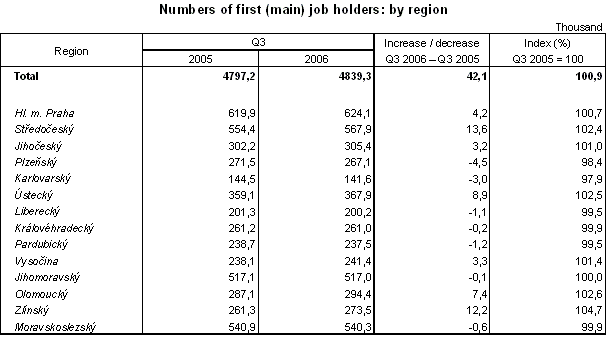
There were almost 95% of persons working full time in their main job in the civil sector of the national economy, which is significantly more than in the other EU states. Nearly 241 thousand persons worked part-time in their main job, most of them were women (178 thousand).
The number of hours actually worked in the reference week reached 36.0 hours, in full-time employment it was 36.9 hours. The differences in working hours of employees are large, both in terms of their professional status and industry (CZ-NACE sections). The self-employed worked approximately 46.6 hours a week, members of producer cooperatives 42.7 hours and with a huge gap the category of full-time employees followed with approximately 35.0 hours worked. In the long term, these differences are apparent both for men and women when generally men work longer in all of the status categories. The most hours worked in their main job had employees in construction (42.6 hours) and in agriculture, hunting and forestry (41.3 hours), the least had employees in education (21.5 hours).

With the growing total employment of the residing population and the economically inactive, the number of the unemployed decreased. The number of unemployed persons (ILO methodology) reached 364.9 thousand on average in Q3 2006, i.e. a fall of 39.7 thousand year-on-year. The number of the unemployed decreased mainly in the age group 25-29 by 12.7 thousand; it also dropped in the age group 35-39 (-6.5 thousand). The number of unemployed men (164.4 thousand in total) is still below the number of unemployed women (200.5 thousand). Under the total year-on-year drop in unemployment, the unemployment of men decreased by 14.5 thousand, and the decrease showed itself in the whole group of 15-54 years old persons, except 30-34-year-old persons. Over the same period, the number of unemployed women decreased by 25.2 thousand in total, and with the exception of the age group 20-24 it dropped in all of the other five years age groups of the productive age.
The number of persons unemployed for a long time (1 year or more) fell by 17.0 thousand. In spite of this total drop, a higher increase was recorded among men aged 30-39 (+2.8 thousand), which is connected to a certain extent with a natural shift in the age structure of the population.
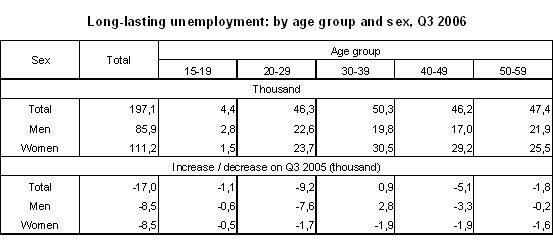
The number of the unemployed with basic education decreased by 10.0% year-on-year to 84.8 thousand, which is connected with a general decrease of the number of persons in the productive age with the lowest level of education. The number of unemployed persons with secondary education without GCSE (with secondary vocational education in particular) decreased by 15.2% to 165.0 thousand and the number of the unemployed with secondary (with GCSE) decreased by 4.6% to 93.0 thousand. The number of unemployed university graduates rose by 20.0% to 22.0 thousand, however the unemployment of university graduates is markedly lower when compared to the first three groups.
Year-on-year, the unemployment dropped particularly in the Moravskoslezský, Zlínský and Středočeský Region, on the other hand compared to Q3 of the last year, the number of unemployed increased in the Královehradecký and Liberecký Region in particular.

The growth of total employment and the decrease in the number of the unemployed resulted in a relatively high decrease of general unemployment rate of persons aged 15-64 (ILO). In comparison to Q3 2005, the general unemployment rate decreased by 0.8 percentage points to 7.1%. It decreased mainly among the female population (by 1.1 percentage points to 8.8%), while it dropped among the men population by 0.5 percentage points to 5.6%. According to the latest complete results of the Eurostat for Q2 2006 the general unemployment rate in the Czech Republic was lower than in the EU25, when with a relatively low unemployment level of men the level of unemployment of women in the CR was practically the same as the total for all EU member states. The big decrease of unemployment during this year in the Czech Republic has a positive effect in both of the comparisons with the EU25 and EU15 countries when in Q2 2006 the unemployment rate in the CR was lower than the average of the EU15.
Compared to the neighbour states, the level of unemployment is higher than in Austria but markedly lower than in Poland and Slovakia, where it is still extremely high and the highest throughout the Union. Our unemployment level is lower also in comparison with Germany mainly due to an unfavourable situation in the long run in the federal states in the regions of former DDR.
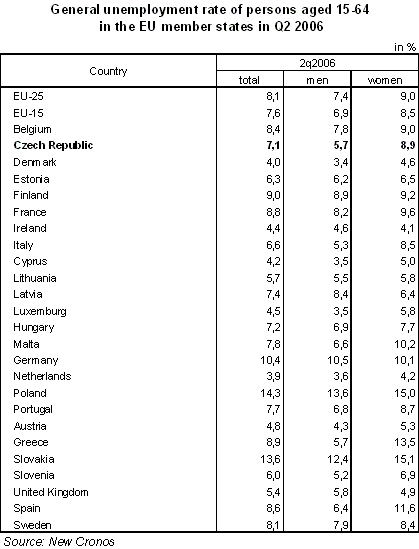
Unlike the total unemployment level, the position of the Czech Republic is less favourable from the point of view of long-term unemployment (1 year and more). In Q4 2005, the share of long-term unemployed in the total unemployment was higher only in three countries, which are our direct neighbours – Germany, Poland, Slovakia. The share of long-term unemployment in the total unemployment increased in the long run in the countries with the biggest share of long-term unemployed, i.e. in Poland and Slovakia. Completely different is the situation in Austria, where only one out of four unemployed was unemployed more than one year
The number of economically inactive persons aged 15+ (according to the LFSS methodology they are persons who had no job and were not seeking a job during last four weeks or did not meet all conditions for being classified among the unemployed) increased by 51.3 thousand year-on-year and reached 3 573.9 thousand in Q3 2006. This category is primarily affected by numbers of the retired and of persons preparing for their future occupation. The number of basic school pupils decreased by 5.5 thousand; the number of secondary school pupils including vocational schools increased by 18.9 thousand to 526.4 thousand. The number of university students including higher professional school students grew by 8.2 thousand to 269.1 thousand. The number of economically inactive normally retired persons not actively seeking job increased by 11.1 thousand to 1 829.6 thousand and the number of persons in early retirement fell by 7.1 thousand to 60.3 thousand. Furthermore, the number of disability pensioners decreased by 46.2 thousand to 260.8 thousand. These figures cannot accurately correspond to the statistics on pupils and students compiled by the Ministry of Education Youth and Sports of the CR or to the numbers of pensioners on the records of the Ministry of Labour and Social Affairs of the CR because the pupils, students or pensioners who fulfilled the criterion of being classified among persons in employment or unemployed persons in the reference week are not reported as economically inactive.
